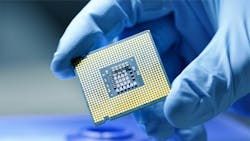Air Force taps Battelle for trusted computing solutions for COTS microelectronics in military applications
WRIGHT-PATTERSON AFB, Ohio – U.S. Air Force researchers are trying to develop trusted computing microelectronics technologies to enable broader use of commercial off-the-shelf (COTS) electronic components in military systems. They found a solution from Battelle Memorial Institute in Columbus, Ohio.
Officials of the Air Force Research Laboratory at Wright-Patterson Air Force Base, Ohio, announced a $24.5 million contract to Battelle late last month for the Assured and Trusted Microelectronics Solutions (ATMS) program.
The rapid improvement cycle for semiconductor technology and systems-on-a-chip (SoC) has made process and equipment upgrades very expensive, triggering state-of-the-art manufacturing foundry operations to consolidate into a few large companies mainly in Asia, Air Force researchers explain.
The resulting lack of trusted, U.S.-based foundries has become a significant concern for the U.S. Department of Defense (DOD) because commercial state-of-the-art foundries for defense-related application-specific integrated circuit (ASIC) development may not meet security and trusted computing requirements.
For the ATMS program, Battelle experts will find ways of extracting security-related requirements; perform post-silicon validation and verification for next-generation microelectronics; develop validation and verifications; and enhance microelectronics supply chain security. MacAulay Brown Inc. in Dayton, Ohio, also has been involved in the ATMS program, based on a $3.2 million contract awarded in June 2019.
The rapid improvement cycle for semiconductor technology and systems-on-a-chip (SoC) has made process and equipment upgrades very expensive, triggering state-of-the-art manufacturing foundry operations to consolidate into a few large companies mainly in Asia, Air Force researchers explain.
Battelle experts will continue efforts to ensure that microelectronics from commercial foundries are trusted, assured, and protected. This applies to currently fielded microelectronics no longer in production; microelectronics in production; and next-generation cutting-edge microelectronics.
Trusted refers to confidence that there is no malicious content. Assured means microelectronics parts have verified function with no extra functions. Protected means these microelectronics parts can prevent unauthorized disclosures as to their designs.
Battelle experts will try to increase the availability of COTS trusted microelectronics that are sustainable and reliable across military mission lifetimes; ensure that military parts are purchased exactly as specified and without additions or alterations; and help maintain stringent IP protection during manufacturing and after fielding.
Ultimately, military leaders want Battelle to develop the ability to field COTS ASICs, systems-on-chip, and field-programmable gate arrays (FPGAs) without putting military systems at risk. The goal is to enable rapid military system modernization and flexibility, increased performance, and less need for unique DOD systems.
To do this, Air Force researchers are asking Battelle to develop technologies that have built-in trust measures; that accelerate circuit development for military systems, and ensure performance for DOD systems.
In addition, Air Force researchers want Battelle to find ways to ensure that DOD maintains access to advanced and legacy integrated circuit technologies in the embedded computing design process.
Examples of embedded design assurance include mechanisms to ensure the integrity of commercial off-the-shelf (COTS) FPGAs through 3PIP analysis, tools, and techniques of the FPGA hardware and bitstream; metrics for FPGA assurance; verification methods to ensure functions; traceability throughout the supply chain; and security circuit implementations and architectures.
Battelle experts also will pursue new microelectronics test and measurement technologies to verify the trust and assurance of components and systems. These could include embedded ASIC structures to assist in post fabrication analysis; high-volume technologies to characterize supply chain risk; non-destructive test techniques; algorithms to reduce analysis time; low-cost evaluation techniques; and fusion technologies that capitalize on several data sets.
The company also will work on enhanced microelectronics fabrication and packaging at high-mix, low-volume foundries. This could involve how 3D and 2.5D packaging could help protect IP and assure trust; advanced integrated photonics; flexible hybrid manufacturing; and technologies that may provide additional security.
The ATMS program also involves new design, manufacturing, and assessment for trusted radiation-hardened electronics in next-generation strategic systems. This could include rad hard by design (RHBD) libraries and new ways to meet strategic radiation levels; dose rate radiation effects testing for COTS devices; radiation testing for FPGAs; and new ways to capitalize on commercial technology and COTS devices for high-reliability strategic-hardened applications.
For more information contact Battelle Memorial Institute online at www.battelle.org, , or the Air Force Research Laboratory at https://www.afrl.af.mil.
About the Author
John Keller
Editor-in-Chief
John Keller is the Editor-in-Chief, Military & Aerospace Electronics Magazine--provides extensive coverage and analysis of enabling electronics and optoelectronic technologies in military, space and commercial aviation applications. John has been a member of the Military & Aerospace Electronics staff since 1989 and chief editor since 1995.
